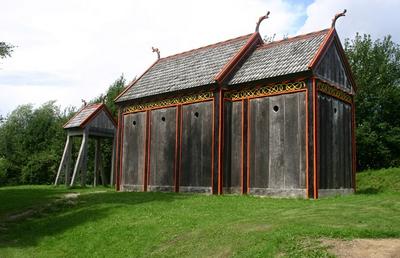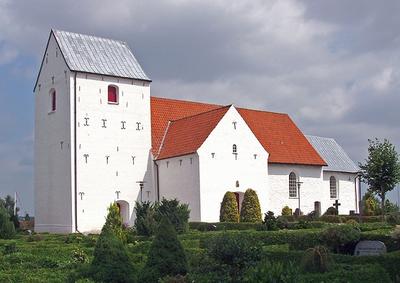The transition to Christianity
Christianity and foreign policy
Religion is an important aspect of almost all societies. The relationship between the belief in the Norse gods and Christianity during the Viking period has been the subject of much discussion.
The Viking transition to Christianity did not just involve religion; politics also played a significant role. In the larger kingdoms south of Denmark, Christian rulers and the Church were powerful forces in Viking Age and medieval Europe. The conquering of countries was praiseworthy if the objective was to Christianize their inhabitants.
When Harald Bluetooth agreed to be baptised around 965, it is unlikely that this was because he was convinced that the Christian religion was the only truthful way. His baptism is believed to have been rather a tactical manoeuvre to hold the German emperor and the archbishop of Hamburg-Bremen at bay. However, in the longer view the Church and Christianity suited the Danish kings very well, as a close relationship with them strengthened royal power.

The threat from the south?
Denmark’s biggest problem in the Viking period was its powerful neighbour to the south – the Holy Roman Empire. After Harald Bluetooth had been baptised, it was harder for the German emperors to interfere in Danish affairs. The Germans were Christian and might have forced the Danes to convert to Christianity, if they had not become Christian of their own free will. Therefore Harald probably thought it was a good political move to become Christian in order to avoid war with the Holy Roman Empire.
In the following centuries Harald and subsequent Danish kings tried to detach themselves from the control of the archbishopric of Hamburg-Bremen. The archbishopric had a strong hold on Denmark in the late Viking period. As a result, the Danish kings tried to link themselves more closely to the English Church, with which there had been close connections throughout the Viking period. In the year 1018 King Canute 'The Great' placed four English bishops at Ribe, Odense, Roskilde and Lund. All of these were important bishoprics at the time.
It was not until the reign of Eric I in the year 1103 that Denmark was granted its first archbishopric and thus was freed from the control of the archbishopric of Hamburg-Bremen. Eric I had travelled to Rome himself in order to negotiate with the pope. However, the price for this was apparently high. Eric now had to divide the land up into parishes and collect tithes for the Church.
Harald Klak - the first Christian Viking king
In 826 Harald Klak consented to be baptised and thus became the first Danish Christian Viking king. Apparently he did not agree to this out of a strong commitment to Christianity. At this point in time Harald was in exile, after having been granted refuge by the Frankish king Louis the Pious (814-840). This exile had resulted from various disputes over the royal rule of Denmark, which arose in the wake of King Godfrey’s death in 810. Subsequently Harald became king, together with his brother in 812-13, and with Godfrey’s sons in the period 819-27.
However, dividing up the land with Godfrey’s sons was not without its conflicts. Therefore Harald twice sought the support of the Frankish king, Louis the Pious. This support was offered on the condition that Harald agreed to be baptised. Harald must have believed that the prize of Denmark was worth taking part in a ceremony for. He agreed to be baptised at a great ceremony at Ingelheim on the Rhine, at which he swore allegiance to the emperor. Louis the Pious was present and rewarded Harald with an estate in Friesland.
Now with the backing of the Frankish king, Harald Klak could make another attempt to seize the Danish throne. Accompanying him on this expedition was the Frankish monk Ansgar (801-865). At the request of the Frankish king, Ansgar was to undertake missionary activity in Denmark under Harald’s protection. Little came of this though, as the year after Harald was driven out of Denmark again, and Ansgar was forced to follow him.
It soon became clear that Harald Klak had been a poor choice to rely upon. Using his estate in Friesland as a base, he now began to undertake acts of piracy, to the great annoyance of the Franks. He does not appear to have taken his Christian faith very seriously.
Christianity - a strengthening of royal power?
The adoption of Christianity was also beneficial to the king. It brought with it a strengthening of royal power in the land. However, Harald Bluetooth needed the support of many powerful magnates in order to take this step, or else his power would be threatened. It seems that Harald received the backing of his supporters, as the earliest traces of churches have been found on magnates’ estates.
After Harald’s baptism, Christianity was initially primarily the preserve of rich magnates and their wives. They possessed the wealth and resources to enable them to build churches. The magnates constructed churches to remain on good terms with the king, but also to secure a place in paradise after death.
But probably not all magnates were willing to follow Harald Bluetooth’s lead. We know that the Pope in Rome forbid the magnates from owning the churches on their estates. Harald’s conversion to Christianity was perhaps not only a necessary evil, but also part of an attempt to wrest power from local magnates. Religious worship, which previously had been the responsibility of local magnates, was now in the hands of the clergy.
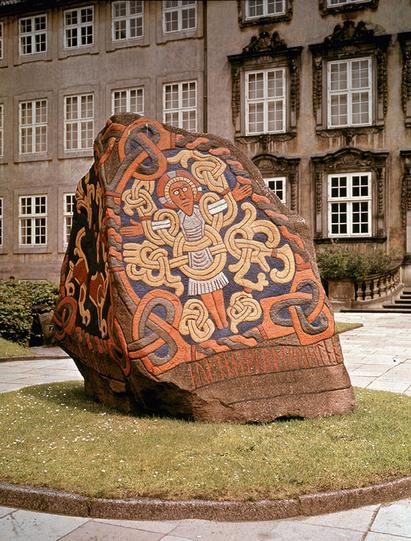
The victorious Christ
The character of Christianity changed on its journey all the way from Palestine to Northern Europe. In Scandinavia Christianity encountered another mentality to that which was found in Southern Europe. The ideal of the Vikings was the warrior and the aim was victory. Therefore “the suffering Christ” on the cross was not received sympathetically amongst the Vikings, and the Christian missionaries instead placed emphasis upon “the victorious Christ”.
Reburial
Examples can be found of people, who having already been buried in a pagan way, were subsequently reburied as Christians. During excavations in Hørning Church a buried woman was discovered, accompanied by valuable grave goods dating to the 900s. The burial was found in a chambered tomb within a mound. Later on the mound was removed and a small wooden church was built directly over the burial chamber. This was probably to ensure that the buried woman came under the protection of the new faith. What the woman would have thought about this, we will never know.
The first churches of the Viking Age
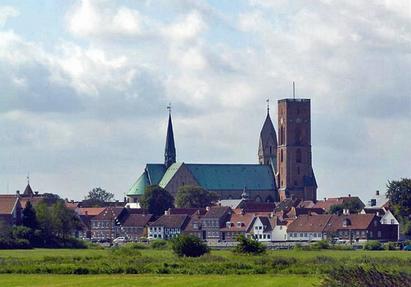
In the Viking period the first churches were built. These buildings were made of wood (stave churches). None of the early wooden churches are preserved today, but traces of them have been found under floors and as timbers forming parts of existing stone churches. Around 30 wooden churches are known from Denmark.
The churches mentioned in the written sources must have been made of wood. We know that around 850 the Danish king Horik I gave the missionary Ansgar permission to build churches in the trading settlements of Hedeby and Ribe. But it is not known whether Ansgar’s churches were ever built, because traces of them have never been found.
However, during excavations at Ribe Cathedral archaeologists found the remains of Viking burials. The graves are likely to have been connected to a church building and date to the 800s or 900s. They are therefore amongst the earliest Christian burials found in Denmark and are evidence that Ansgar’s missionary work had been a success. Perhaps the remains of Ansgar’s church lie under today’s Ribe Cathedral.
During the course of the 1000s many of the wooden churches of the Viking Age were replaced by stone churches. The master builders of the stone churches are believed to have come from England. An example of this English influence can be found at the Church of St Jørgensbjerg in Roskilde. Here a door portal has a very unusual design. Examples of similar doorways are known from Eastern England. This indicates that it was English craftsmen who introduced revolutionary stone building techniques to Denmark. The Church of St Jørgensbjerg was built in the 1020s and is considered to be one of the oldest stone churches in Denmark. It was originally called St Clement’s, after the seafarers’ guardian, who was popular in England. This also strengthens the theory of English influence.
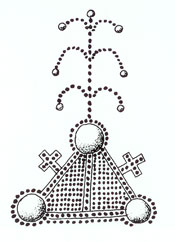
Ansgar and his ”expeditions” to the North
The missionary Ansgar (801-865 AD) had the task of spreading knowledge of Christianity amongst the “heathens” of the North. He was employed by the archbishopric of Hamburg-Bremen. Ansgar is especially well known today because of the “biography” describing his deeds, which was written about him.
Ansgar was a missionary in Scandinavia. At this time it would have been beneficial to the Frankish emperors if Northern Europe adopted Christianity, as this might result in fewer problems with these neighbours. The Vikings might not make violent attacks if they became Christians.
In 826 AD Ansgar undertook a missionary journey to spread knowledge of Christianity amongst the Saxons, and perhaps also the Danes, of Southern Jutland. Around the year 830 AD he travelled to Sweden, where he worked especially in the trading town of Birka. According to the account of his life, he was given permission to build a church at Birka – possibly the first church in Scandinavia?
Subsequently Ansgar was named archbishop of Hamburg and was given Scandinavia as his area of responsibility. His job was mainly to act as a diplomat between the Danish kings and the Frankish emperors. He was also given permission to build churches at Ribe and Hedeby.
Ansgar was not the only missionary from the Frankish area, but he is one of the few that we have information about, because of the biography of him that was written.
